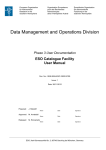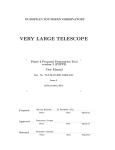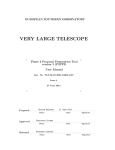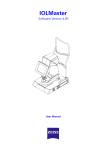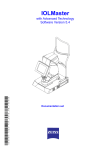Download ESO Phase 3 User Guide to the Data Submission Process
Transcript
European Organisation for Astronomical Research in the Southern Hemisphere Organisation Européenne pour des Recherches Astronomiques dans l’Hémisphère Austral Europäische Organisation für astronomische Forschung in der südlichen Hemisphäre Data Management and Operations Division ESO Phase 3 User Guide to the Data Submission Process Doc. No.: GEN-SPE-ESO-33000-xxxx Issue: 2 Date: 09.03.2011 Prepared: Approved: J. Retzlaff Name Date Signature Name Date Signature Name Date Signature M. Arnaboldi Released: ESO, Karl-Schwarzschild-Str. 2, 85748 Garching bei München, Germany ESO Phase 3 User Guide to the Data Submission Process Doc: Issue Date Page GEN-SPE-ESO-33000-xxxx 2 09.03.2011 2 of 21 CHANGE RECORD ISSUE DATE SECTION/PARA. AFFECTED 1 27.11.2010 All 2 07.03.2011 3, 4.11, 4.12 All REASON/INITIATION DOCUMENTS/REMARKS Initial issue of the Phase 3 User Guide to support the ESO Public Surveys Phase 3 Workshop, ESO Garching, 30.11.2010. Added Figures updated ESO, Karl-Schwarzschild-Str. 2, 85748 Garching bei München, Germany ESO Phase 3 User Guide to the Data Submission Process Doc: Issue Date Page GEN-SPE-ESO-33000-xxxx 2 09.03.2011 3 of 21 TABLE OF CONTENTS 1 Purpose and Scope...........................................................................................................................4 2 List of Applicable Documents............................................................................................................4 3 Overview of the Phase 3 Process .....................................................................................................5 3.1 Define new data release ............................................................................................................5 3.2 Delegate Phase 3 permissions ..................................................................................................5 3.3 Prepare the data ........................................................................................................................5 3.4 Validate the data ........................................................................................................................5 3.5 Upload the data to ESO .............................................................................................................5 3.6 Create and upload the release description ................................................................................5 3.7 Closing the release ....................................................................................................................5 3.8 ESO validates the submitted data .............................................................................................6 3.9 ESO archives and publishes the data........................................................................................6 4 Step-by-step user guide to the Phase 3 data submission process ...................................................7 4.1 Enter the Phase 3 Release Manager.........................................................................................7 4.2 Log in to the ESO User Portal ...................................................................................................7 4.3 Choosing your programme ........................................................................................................7 4.3.1 Principal investigator of ESO public survey or large programme .......................................7 4.3.2 Co-Investigator ...................................................................................................................7 4.3.3 Principal investigator of normal ESO programme ..............................................................8 4.3.4 Data products resulting from archival research ..................................................................9 4.4 Delegating the Phase 3 process ................................................................................................9 4.5 Defining the ESO data release ................................................................................................10 4.5.1 Data collection and data release ......................................................................................10 4.5.2 Guidelines.........................................................................................................................11 4.5.3 Initial data release ............................................................................................................12 4.5.4 Subsequent data release..................................................................................................13 4.6 Adding data products to the release ........................................................................................14 4.6.1 Validating the data using the Phase 3 Release Validator.................................................14 4.6.2 FTP data upload ...............................................................................................................14 4.7 Submitting the data release description...................................................................................15 4.8 Closing the data release ..........................................................................................................16 4.9 Data release validation ............................................................................................................17 4.10 Data release becomes public ................................................................................................17 4.11 Updating data collections.......................................................................................................18 4.11.1 Adding new data products ..............................................................................................19 4.11.2 Revising the data collection............................................................................................19 4.11.2.1 Updating and complementing .................................................................................19 4.11.2.2 Totally replacing the previous content.....................................................................20 4.12 Reviewing the release content...............................................................................................21 ESO, Karl-Schwarzschild-Str. 2, 85748 Garching bei München, Germany ESO Phase 3 User Guide to the Data Submission Process Doc: Issue Date Page GEN-SPE-ESO-33000-xxxx 2 09.03.2011 4 of 21 1 Purpose and Scope Phase 3 denotes the process in which principal investigators of ESO observing programmes return their reduced data products to ESO for storage in the ESO archive and subsequent data publication to the scientific community.1 To ensure the successful integration of External Data Products (EDPs) into the archive, ESO supports the users in carrying out the Phase 3 process by defining ESO/EDP data standards, by devising procedures and providing the infrastructure for the delivery of EDPs, and by supplying tools for the data preparation. This document provides a user guide to the ESO Phase 3 data submission process. It is intended to carry the user through each step of the submission process once the data has been prepared according to the ESO External Data Products Standard defined in [1] (see below). The target audience consists of principal investigators and their collaborators who return reduced data products resulting from ESO observations for public release to the astronomical community through the ESO archive. 2 [1] List of Applicable Documents ESO External Data Products Standard, Issue 2, Date: 09.03.2011 http://www.eso.org/sci/observing/phase3/p3edpstd.pdf and documents referenced therein. 1 See http://www.eso.org/sci/observing/phase3 for the main entry point to the ESO Phase 3. ESO, Karl-Schwarzschild-Str. 2, 85748 Garching bei München, Germany ESO Phase 3 User Guide to the Data Submission Process Doc: Issue Date Page GEN-SPE-ESO-33000-xxxx 2 09.03.2011 5 of 21 3 Overview of the Phase 3 Process The Phase 3 process consists of the following steps. 3.1 Define new data release Go to the Phase 3 Release Manager (http://www.eso.org/sci/observing/phase3/rm), a dedicated web application for controlling the Phase 3 process, to define a new data release. As the principal investigator of an ESO programme you organise your data products according to appropriate highlevel criteria into self-consistent groups, called data collections, which, subsequently, the archive user can browse and access. Later on you may issue further releases to add more data or to update already released data products. More about the concepts of data collection and release, see §4.5. 3.2 Delegate Phase 3 permissions As the principal investigator you can delegate the Phase 3 process for your ESO programme to one or more persons of your choice to distribute the effort of data submission and release preparation. How to set up Phase 3 delegation, see §4.4. 3.3 Prepare the data The data should be prepared according to the ESO External Data Products Standard [1], which specifies data product types and their formats. Download the ESO External Data Products standard from http://www.eso.org/sci/observing/phase3/p3edpstd.pdf. 3.4 Validate the data You validate the data before uploading to ESO using the Phase 3 Release Validator, a java-based tool to be run locally on your system. Repeat the validation until you obtain as result the "OK" for data upload. Download the software and its documentation from http://www.eso.org/sci/observing/phase3/validator. 3.5 Upload the data to ESO You upload the data via secure FTP to the dedicated server phase3ftp.eso.org. For this purpose a suitable client like lftp or FileZilla has to be used. Find more information about uploading your data in §4.6. 3.6 Create and upload the release description You create and upload the data release description, which provides an account of the release content, the originating observations, the calibration and data reduction procedures, the data quality, the data format, and, possibly, the scientific context of the programme. More about the preparation and submission of the data release description, see §4.7. 3.7 Closing the release By closing the release you approve the completeness and correctness of the submitted data and its description. Furthermore, you agree to the publication of the data and the associated data release description. You close the data release using the Phase 3 Release Manager. Closing the data release turns the data on the FTP area into read-only state, i.e. you cannot modify existing files or add new data anymore. More about closing the data release, see §4.8. ESO, Karl-Schwarzschild-Str. 2, 85748 Garching bei München, Germany ESO Phase 3 User Guide to the Data Submission Process Doc: Issue Date Page GEN-SPE-ESO-33000-xxxx 2 09.03.2011 6 of 21 3.8 ESO validates the submitted data This is a two-step process, consisting of an automatic validation of the data format followed by a manual validation of the content and its description. If the validation fails, the release state will change from CLOSED to ERROR and you will receive a notification by e-mail, which prompts you to correct the problems and to CLOSE the release again. 3.9 ESO archives and publishes the data The data release will be archive and becomes public after the validation process has been concluded. The community will be able to access the data via specifc query interfaces in the ESO archive web pages. You will be notified about the actual date of public release. ESO, Karl-Schwarzschild-Str. 2, 85748 Garching bei München, Germany ESO Phase 3 User Guide to the Data Submission Process 4 Doc: Issue Date Page GEN-SPE-ESO-33000-xxxx 2 09.03.2011 7 of 21 Step-by-step user guide to the Phase 3 data submission process 4.1 Enter the Phase 3 Release Manager Navigate your web browser to http://www.eso.org/sci/observing/phase3/rm to access the ESO Phase 3 Release Manager – a web application to manage the process of data submission and release through the ESO science archive facility. The Release Manager allows ESO users to manage their ESO Phase 3 programmes, to create new data collections and releases, to manage the work-flow of data releases, and to view the contents of archived data releases. 4.2 Log in to the ESO User Portal Unless you already have logged in to the ESO User Portal with your web browser, you will be asked by the system to identify yourself with your personal ESO User Portal credentials (Figure 1). As a principal investigator of an ESO programme you are familiar with the ESO User Portal from the proposal submission and observing preparation procedures. If you are not a registered user of the ESO User Portal, first, you will need to register yourself before proceeding. To this end please click on the link named “I would like to create a new account” near the bottom of the ESO User Portal welcome page, which carries you to the registration dialogue. After having created a new User Portal account, you can log in and proceed with the following step of the Phase 3 submission process. 4.3 Choosing your programme The first administrative step of the data submission process is the identification of the ESO programme for which you are going to submit data products. The entry point of the Phase 3 Release Manager application has two tabs, listing the Phase 3 programmes that you own, and the list of programmes delegated to you, like shown in Figure 2. 4.3.1 Principal investigator of ESO public survey or large programme If you are the principal investigator of an ESO public survey or large programme, your programme is already registered and listed in the Phase 3 release manager. If you own multiple programmes all of them are listed. In order to choose the programme to submit data for, just click on its name (cf. Fig. Figure 2), which navigates you to the overview of data collections for this programme. If, by mistake, your programme is missing from the list, please contact [email protected], Subject: Phase 3, via email. 4.3.2 Co-Investigator If you act as a Phase 3 delegate on behalf of the principal investigator of an ESO public survey or large programme, typically being Co-Investigator of the programme, you can pick the programme to submit data for from the list of delegated programmes, by clicking on the respective name. If the programme is missing from the list, please contact the respective principal investigator to request Phase 3 delegation for this programme. ESO user support is not able to effect Phase 3 delegation because authorization by the programme’s principal investigator is strictly required. To setup Phase 3 delegation as principal investigator, see §4.4, page 9. ESO, Karl-Schwarzschild-Str. 2, 85748 Garching bei München, Germany ESO Phase 3 User Guide to the Data Submission Process Doc: Issue Date Page GEN-SPE-ESO-33000-xxxx 2 09.03.2011 8 of 21 Figure 1: The ESO User Portal login page Figure 2: Entry page of the Release Manager 4.3.3 Principal investigator of normal ESO programme If you are the principal investigators of a normal ESO programme, i.e. neither ESO public survey nor large programme, and you intend to submit data resulting from this programme for the first time, you need to request the registration of your progamme for Phase 3 submission by sending an email message to [email protected], subject: REQUEST FOR PHASE 3 PROGRAMME <PPP.C-NNNN>, where <PPP.C-NNNN> denotes your ESO programme identifier. The body of the message should be empty. Thereafter, usually within one working day, you will receive by email the confirmation that the ESO, Karl-Schwarzschild-Str. 2, 85748 Garching bei München, Germany ESO Phase 3 User Guide to the Data Submission Process Doc: Issue Date Page GEN-SPE-ESO-33000-xxxx 2 09.03.2011 9 of 21 programme has been registered and you can proceed by picking the respective programme from your list of programmes being displayed by the Phase 3 Release Manager. 4.3.4 Data products resulting from archival research If you have carried out research being primarily based on ESO archival data rather than on ESO data that has been obtained in the course of your own ESO observing programme, you are encouraged to submit the resulting data products to ESO for public release through the ESO science archive facility. To this end you need to request the registration of a dedicated Phase 3 programme by sending an email message to [email protected], Subject: Phase 3, indicating the name of your research project and the type of data products to be submitted. Thereafter, usually within one working day, you will receive by email the confirmation that the programme has been registered and you can proceed by picking the respective programme from your list of programmes being displayed by the Phase 3 Release Manager. 4.4 Delegating the Phase 3 process As the principal investigator of an ESO programme you can delegate the Phase 3 process to one or more persons of your choice to distribute the effort of data submission and release preparation. The principal investigator can delegate the Phase 3 per programme to any ESO user, i.e. a person being registered with the ESO User Portal. A delegate can create new collections and data releases and can submit data products in the same way as the principal investigator can do. The principal investigator can revoke at any time any delegation rights he might have granted. Multiple delegates can, in principle, work on the same data release but it is in the sole responsibility of the principal investigator to ensure the overall consistency. From the top-level page of the Phase 3 Release Manager showing the overview of programmes, choose the link “Manage programme permissions” below the table of your programmes near to the bottom of the screen to view and administrate delegation settings (Figure 2). This brings you to the page for managing programme permission from where the following actions can be taken (Figure 3): • Delegate a programme to another user registered in the ESO user portal (by entering his/her e-mail address and clicking delegate ) • Revoke the permissions from an existing delegated programme (by clicking on revoke ) To return to the Release Manager, click on the name of one of your programmes which brings you to the list of data collections of this programme as shown in Figure 4. The final action of closing a data release cannot be delegated but the principal investigator in person has to take this action to approve the completeness and quality of the data and the accuracy of the associated description. Closing a data release represents a crucial step in the course of the Phase 3 process because the operations following thereafter and leading to the public release of the data through the ESO Archive are being executed by the system in a largely automatic fashion. ESO, Karl-Schwarzschild-Str. 2, 85748 Garching bei München, Germany ESO Phase 3 User Guide to the Data Submission Process Doc: Issue Date Page GEN-SPE-ESO-33000-xxxx 2 09.03.2011 10 of 21 Figure 3: Page for managing permissions for Phase 3 delegation Figure 4: List of data collections resulting from the selected programme 4.5 Defining the ESO data release After programme selection the Release Manager takes you to the page displaying the list of data collections for this programme (Figure 4). In the last preparatory step before you can actually start to submit data products, the ESO data collection and data release have to be defined. 4.5.1 Data collection and data release Data collection and data release provide the framework that supports the data submission process and facilitates data access through the ESO archive. The data collection allows organising the data products from a given programme according to the principal investigator’s high-level criteria into selfconsistent groups, which, subsequently, the archive user can browse and access. The data release is primarily a container for the data products to be submitted and released together. ESO, Karl-Schwarzschild-Str. 2, 85748 Garching bei München, Germany ESO Phase 3 User Guide to the Data Submission Process Doc: Issue Date Page GEN-SPE-ESO-33000-xxxx 2 09.03.2011 11 of 21 The concepts of data collection and data release are closely related to each other. The two form a simple hierarchical structure where data collection is at the top and any data release must be associated to one and only one data collection. The other way around, any data collection must have at least one data release to be functional. The data collection consists of a series of data releases tagged by incremental numbers starting from one. All the data releases belonging to a given data collection inherit the data collection’s name. The individual data release may be considered a version of the data collection. Initially, any collection consists of the first data release (“Data Release 1”). Subsequent data releases for the same collection may follow to add more data according to the observing programme’s progress. It is also possible to submit a revised version of a previously released data product. 4.5.2 Guidelines Each data collection is defined by its name and by the set of data products being members of the associated data releases. The collection name has to be defined at the time of starting the data submission and cannot be revised later by the user. Each data release has to be accompanied by a description of its content, data properties and format to enable the archive user to employ the data for their own scientific research (the release description, see below). For ESO large programmes, it is common practice to organize the data products according to the scientific publications that have been generated thereof. One data collection may correspond to one target object. Otherwise, for programmes that consist of independent observations with multiple instruments, data collections might be defined by instrument. The type or number of data products are not useful criteria for the definition of data collections. In practice, one ESO programme may result in a single data collection, like, e.g., the zCOSMOS galaxy redshift survey. Figure 5: Creating a new collection ESO, Karl-Schwarzschild-Str. 2, 85748 Garching bei München, Germany ESO Phase 3 User Guide to the Data Submission Process Doc: Issue Date Page GEN-SPE-ESO-33000-xxxx 2 09.03.2011 12 of 21 Figure 6: Newly created data collection without releases 4.5.3 Initial data release If you are submitting data products for your programme for the first time, the list of data collections is empty and the name of the data release under which the data submission takes place must be defined in the Phase 3 Release Manager by clicking the menu item “Add collection” (see Figure 4). This system prompts you for the name of the data collection (Figure 5). Note that the collection name should not contain any number indicating the version or alike because the data releases will be automatically assigned an integer numbers incrementing with each release. The collection name is subject to the following conditions: it must start with a letter and should not contain any white space; use the underscore character (“_”) instead. To proceed, click on the name of the newly created data collection, which brings you to the empty list of releases for this collection (Figure 6). That followed, the initial data release for this data collection must be created be clicking the menu item “Create a new batch release”. The system automatically assigns the data release number 1 to the newly created initial data release. Now, you can enter a comment in the respective field and a list of email recipients to be notified about the progress of the Phase 3 process for this release (Figure 7). The ESO/EDP user support scientist while reviewing the content and validating the overall consistency of the data release will take the comment into account. Because the comment itself will not be published, it is primarily intended to pass information regarding the actual Phase 3 process rather than information about the data. The later should always go into the release description, which will be made publically available. Eventually, click the Save button to create the new data release. ESO, Karl-Schwarzschild-Str. 2, 85748 Garching bei München, Germany ESO Phase 3 User Guide to the Data Submission Process Doc: Issue Date Page GEN-SPE-ESO-33000-xxxx 2 09.03.2011 13 of 21 Figure 7: Creating a new data release 4.5.4 Subsequent data release If you are submitting data products for your programme for which you have a previous data release, there are the following options. 1. If the new data extend or revise the existing data collection, first, choose the collection by clicking the collection name, then, choose the menu item “Update or complement previous batch release” (Figure 8). The system automatically increments and assigns the data release number to the newly created data release. See §4.11 for more details. 2. If the new data should replace previously published data, first, choose the collection by clicking the collection name, then, choose the menu item “Create superseding batch release” (Figure 8). The system automatically increments and assigns the data release number to the newly created data release. 3. Alternatively, if the new data does not logically belong to the existing data collection, you should create a new data collection by clicking the menu item “Add collection” in the Phase 3 Release Manager’s data collection page (Figure 4). Please take into account that the name of the data collection must be unique within the programme and that the collection name does not contain any number indicating the version or alike. ESO, Karl-Schwarzschild-Str. 2, 85748 Garching bei München, Germany ESO Phase 3 User Guide to the Data Submission Process Doc: Issue Date Page GEN-SPE-ESO-33000-xxxx 2 09.03.2011 14 of 21 Figure 8: The initial data release of this collection has been archived. From this screen the user can commence the next release, either superseding or updating the previous one. 4.6 Adding data products to the release 4.6.1 Validating the data using the Phase 3 Release Validator The local validation of the data release is an essential preparatory step before uploading the data to ESO. In this process the internal consistency and the metadata content of the data products will be checked against the ESO/EDP standard. For this purpose ESO provides a dedicated Java tool – the Phase 3 Release Validator. The validator is run on the local host from the command line using the calling sequence java -jar validator.jar -r <dir> -m create|update The executable code including a comprehensive user manual is available online at http://www.eso.org/sci/observing/phase3/validator 4.6.2 FTP data upload Having defined and successfully validated the data release, you are ready to transmit your data products to ESO for which a dedicated FTP server has been installed. You may use any FTP client of your choice that supports secure authentication (TLS), see below for a list of compatible clients. You may consider the powerful and free FileZilla (http://filezilla-project.org/) as FTP client, which provides a graphical user interface and supports abort/resume functionality among other useful features, or the 2 command-line client lftp (http://lftp.yar.ru/), which comes with many Linux distributions by default. First, connect to the FTP server at phase3ftp.eso.org and login with your ESO User Portal credentials. Then, change to the directory 2 Find a list of compatible FTP clients at http://www.eso.org/sci/observing/phase3/ftp_upload ESO, Karl-Schwarzschild-Str. 2, 85748 Garching bei München, Germany ESO Phase 3 User Guide to the Data Submission Process Doc: Issue Date Page GEN-SPE-ESO-33000-xxxx 2 09.03.2011 15 of 21 /<Phase 3 programme>/<Data collection name>/batch_<Data release number> For example, for the VISTA Hemisphere Survey with Programme Name: VHS Data Collection Name: SGP Data Release: #1 the complete path would read /VHS/SGP/batch_1 Thereafter, you can start transferring your set of products. Since FITS checksums are employed to safeguard the data transfer against transmission errors, it is essential that you properly update the respective checksum keywords beforehand (see [1], §3.6.8). For non-FITS format ancillary files there is a special mechanism in place to catch possible transmission errors employing their MD5 hashes. You have the option to specify the MD5 hash using the dedicated keyword ASSOMi in the science file defining the data set (see [1], §3.6.2). Then, the Phase 3 validator detects any data inconsistency before the files will be archived. The directory and the data deposited therein are visible and accessible just for you as the programme owner and for your delegates. In the course of preparing the data release you can modify files on the FTP server as needed, including file removal. As a data provider you also control the data flow in time. You may transfer the files for a data release in one go or you may accumulate them on the FTP server over a period of time before you close the release. This flexibility allows adapting the submission process to the particular needs due to data processing and verification activities of each programme. If no more data is being added, the data will be kept on the FTP server for a period of three months unless the release is closed before. 4.7 Submitting the data release description The principal investigator is responsible for the content of the data release description and for its delivery to ESO along with the data submission. The release description consists of formatted text typically supplemented by images and tabular information as needed. The following file formats are accepted: plain text (ASCII), HTML, Microsoft Word (*.doc), for images: JPEG, TIFF, GIF, and PNG. The files belonging to one release description should be bundled into a single file using the tar utility. The release description with the filename release-description.tar has to be placed into the release directory of the FTP area. ESO/EDP is in charge of editing and formatting the release description and of publishing the information on the ESO web site including appropriate links to the archived data products. ESO, Karl-Schwarzschild-Str. 2, 85748 Garching bei München, Germany ESO Phase 3 User Guide to the Data Submission Process Doc: Issue Date Page GEN-SPE-ESO-33000-xxxx 2 09.03.2011 16 of 21 Figure 9: Closing a data release Figure 10: Failed data release validation results in ERROR status 4.8 Closing the data release The PI concludes the data submission by closing the data release, an action that cannot be delegated but has to be taken by the principal investigator in person. Normally, thereafter, the release and its content cannot be changed anymore. By closing the release the principal investigator approves the completeness and correctness of the submitted data and its description. Furthermore, the principal investigator agrees to the publication of the data being currently stored in the release directory of the staging area and to the publication of the associated data release description. ESO, Karl-Schwarzschild-Str. 2, 85748 Garching bei München, Germany ESO Phase 3 User Guide to the Data Submission Process Doc: Issue Date Page GEN-SPE-ESO-33000-xxxx 2 09.03.2011 17 of 21 Before of closing a data release, its completeness should be carefully checked because the automatic validation procedures cannot detect if data is missing. The PI can close the data release with the Phase 3 Release Manager by clicking the CLOSE button on data release page (Figure 9). Closing the data release turns the data on the FTP area into read-only state, i.e. you cannot modify existing files or add new data anymore. The operations following thereafter and leading to the public release of the data through the ESO Archive are being executed by the system in a largely automatic fashion without further interacting with the user assuming that the submitted data pass the validation process. After successful validation ESO automatically archives and publishes the data release. 4.9 Data release validation The validation process carried out at ESO consists of two stages. First, there is a fully automatic procedure checking the internal consistency and metadata content of the submitted data products, which is basically identical to the user-side validation. If this validation fails, the release state will change from CLOSED to ERROR, you will receive a notification by e-mail, which prompts you to correct the problems and to CLOSE the release again (Figure 10). You can avoid this type of error by validating all products on your side before of submission. If the release hasn't passed the automatic validation you can click the respective link to “Show the Validation Report”. The second level of validation is performed by the ESO Phase 3 support scientist and consists of reviewing the release content and description at large in order to spot possible issues. The problems typically found in the course of this process lie in the following areas: adequacy and consistency of the data release description, data quality issues, and metadata content. In case of a problem the PI and the contacts given in the CC list will be contacted by email to discuss the issue and to agree on corrective actions. Depending on the nature of the problem, the release state may have to be reverted to “OPEN” to allow the PI to modify the submitted data. 4.10 Data release becomes public The data release will be archive and becomes public after the validation process has been concluded (Figure 10). Each data release is announced using the appropriate ESO channels, e.g. through the ESO science news and the ESO archive news feed. The PI and the contacts given in the CC list will be notified about the actual date of public release. Figure 11: Creating an "updating" data release ESO, Karl-Schwarzschild-Str. 2, 85748 Garching bei München, Germany ESO Phase 3 User Guide to the Data Submission Process Doc: Issue Date Page GEN-SPE-ESO-33000-xxxx 2 09.03.2011 18 of 21 Figure 12: After having created an “updating” data release, the content description file, named CONTENT.ESO, must be downloaded to enable local validation of the data release. Figure 13: Closing an "updating" data release 4.11 Updating data collections This section ties in with the data release definition in case you already have a previous data release for your programme as outlined in §4.5.4. ESO, Karl-Schwarzschild-Str. 2, 85748 Garching bei München, Germany ESO Phase 3 User Guide to the Data Submission Process Doc: Issue Date Page GEN-SPE-ESO-33000-xxxx 2 09.03.2011 19 of 21 4.11.1 Adding new data products If you want to extend the existing collection by adding new data products without modifying the previous content please go through the following steps. 1. Create the data release in the Release Manager by clicking “Update or complement a previous batch release” (Figure 8 and Figure 11). 2. Download the file named CONTENT.ESO of the preceding release from the Release Manager to your local disk and place it in the base directory that holds the data products of this release (Figure 12). 3. Validate the data release using the Phase 3 Release Validator with the command line option -m UPDATE 4. Transfer the data to the phase3ftp server provided that the release passed the validation 5. CLOSE the release using the Release Manager (Figure 13). As a result, the data collection contains the data products of the previous release plus the new products of this release/submission. The incremental fashion of building up a data collection is suitable for large observing programmes, especially if a large number of targets or a large sky area is aimed for. 4.11.2 Revising the data collection 4.11.2.1 Updating and complementing The general procedure described below allows adding, replacing, and removing of individual data 3 products. There are two primary reasons for replacing data products. (i) For large observing programmes that build up depth with time, e.g. the UltraVISTA survey, the latest data product resulting from the combination of the whole set of observations that have been acquired so far supersedes the previous product of this type. (ii) A data product may be submitted a second time because its quality has been improved, due to advanced data calibration or upgraded data reduction procedures. Removing a previously released data product from a data collection is a rare event that happens only if a substantial quality problem has been identified for which there is no fix. 1. Create the data release in the Release Manager by clicking “Update or complement a previous batch release” (Figure 8 and Figure 11). 2. Download the file named CONTENT.ESO of the preceding release from the Release Manager to your local disk and place it in the base directory that holds the data products of this release (Figure 12). 3. Create the special file CHANGES.USER to indicate the deletion or replacement of products if needed. 4. Validate the data release using the Phase 3 Release Validator with the command line option m UPDATE 5. Transfer the data including the CHANGES.USER file to the phase3ftp server provided that the release passed the validation 6. CLOSE the release using the Release Manager (Figure 13). CHANGES.USER is a plain text format file written by the user. It contains the instructions to remove or replace files of the previous release using one line per file following the scheme {DELETE|REPLACE} <filename> 3 Note that replacing and removing of files applies to the current and possible future data release for this collection. The replaced and removed files remain in the ESO archive and can be retrieved on demand by explicitly specifying the number of the previous data release. ESO, Karl-Schwarzschild-Str. 2, 85748 Garching bei München, Germany ESO Phase 3 User Guide to the Data Submission Process Doc: Issue Date Page GEN-SPE-ESO-33000-xxxx 2 09.03.2011 20 of 21 Example of the CHANGES.USER file REPLACE v20091023_00353_st_tl.fits REPLACE v20091023_00365_st_tl.fits REPLACE v20091023_00377_st_tl.fits REPLACE v20091023_00395_st_tl.fits DELETE v20091023_00407_st_tl.fits 4.11.2.2 Totally replacing the previous content This procedure serves the particular purpose of removing the previous content of the data collection altogether and substituting it with new content. This operation should be executed with caution and only if new versions of all the previously released data products will be submitted again. 4 The steps for replacing the previous content of the data collection are as follows: 1. Create the data release in the Release Manager by clicking “Create superseding batch release” (Figure 8 and Figure 14). 2. Validate the data release using the Phase 3 Release Validator with the command line option -m CREATE 3. CLOSE the release using the Release Manager as usual. Figure 14: Creating a "superseding" data release 4 Note that the procedure for updating the collection (§4.11.2.1) using the CHANGE.USER file with REPLACE/DELETE actions for every single file of the previous release would achieve exactly the same result. ESO, Karl-Schwarzschild-Str. 2, 85748 Garching bei München, Germany ESO Phase 3 User Guide to the Data Submission Process Doc: Issue Date Page GEN-SPE-ESO-33000-xxxx 2 09.03.2011 21 of 21 Figure 15: Displaying the contents of an archived release. 4.12 Reviewing the release content The “Contents” tab on the release information screen allows displaying the list of uploaded files on the FTP server as long as the release is in the “open” state. Once the data has been archived, this tab displays the contents organized by data sets (Figure 15). ESO, Karl-Schwarzschild-Str. 2, 85748 Garching bei München, Germany






















